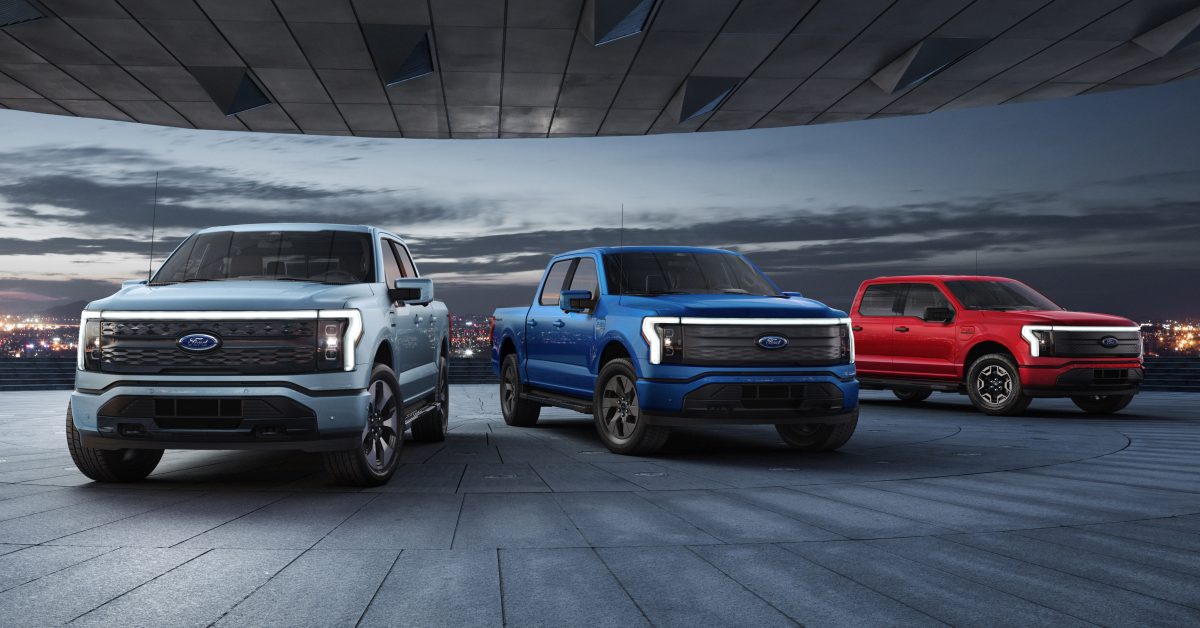Ford is going hard on electrification, with a solid showing at this year’s LA Auto Show and big reservation numbers for the F-150 Lightning. Ford has declared its intent to be the biggest EV maker in the world with a big increase in production in the next few years.
But even with all of that, it’s still not enough. By our estimates, with Ford’s planned production ramp, F-150s won’t be readily available without a wait for the better part of the decade.
Ford has upped its production plans for the F-150 before and announced big investments into adding EV production capacity. But as we’ve said before, it looks like the company’s going to have to do it again.
Currently, Ford is planning to build 15,000 F-150s in 2022, 55,000 in 2023, and 80,000 in 2024. After that, the company will shift to its new EV-only TE1 truck platform.
But that’s 150,000 trucks on the current platform, and at the beginning of this month, Ford shared that it has 160,000 reservations for the F-150 Lightning, up from 120,000 in August. And Ford now says the number is “approaching 200,000,” but that’s a fuzzy number so let’s stick with 160,000 for now.
So not only is Ford’s entire production plan for this model sold out three years ahead of time, but in the last 2.5 months, it has sold at least six months’ worth of its 2024 run rate. And that’s despite the reservation holders knowing that they have a three-year wait ahead of them.
But that’s not all. Ford confirmed to us at the LA Auto Show that this 160,000 number does not include commercial/fleet customers through Ford’s “Ford Pro” program. An entire trim level of the F-150 Lightning, the base $39,974 “Pro” model, is aimed towards these customers.
Ford also said it would not preferentially treat high-optioned orders, and rather produce a mix of option levels. Surely Ford will want to keep its fleet customers happy, so some sales will be diverted in that direction.
Even if we account for attrition in reservations – people who reserved on a lark and end up getting a different vehicle instead – it still seems like demand is much higher than planned production. Surely, when the truck hits the road and word of mouth gets out – and when reservation lead time is shorter (will it ever be?) – more orders will materialize from those who are currently on the sidelines.
So put all of this together, and you’ve got a situation where, with current production plans, this truck is going to be sold out for the foreseeable future.
It’s a better problem to have than lack of demand, but it’s still a problem. Those customers are ready to jump in but just don’t have a product available to them, and might end up being lost to another company.
Or, worse, they’ll buy a gas-powered vehicle that will keep polluting the atmosphere for another decade. According to two surveys, the majority of Lightning reservation holders will be coming over from gas vehicles, which means the more Lightnings that get sold, the less gas we will burn, which is better for everyone.
But in the mentioned timeframe, despite incredible demand for the Lightning, Ford will continue selling millions of gas F-150s, each of which will emit about 100 tons of carbon over their lifetimes, along with other pollutants that form smog and harm health. And these higher-polluting vehicles should be the first priority to get off the road for pollution reduction purposes, rather than the small hatchbacks that most companies started their EV transitions with.
Ford states that it wants to ramp as quickly as demand will allow (there’s that “demand” word again), but that the main limiting factor is the availability of components for electrification. Ford was coy when we asked which specific components the company was talking about… but we all know it’s the batteries.
Ford is spending tens of billions on battery and electric truck production, so it’s preparing for this eventuality. But it still feels like its production numbers are a significant underestimate of the amount of demand that could be out there for a more available vehicle.
Ford did state Thursday that it plans to produce 600,000 EVs in 2023, which means just under 10% of those will be Lightnings. Currently, the gas F-150 makes up about 15-20% of Ford’s total vehicle production (900k out of 5-6 million globally), which means the Lightning will be a lower proportion of Ford’s EV sales than the F-150 is of its overall sales. Given that Ford has fewer planned electric models than gas models for 2023, one would think the Lightning could make up a larger proportion than the F-150, so there’s a disconnect there.
But this 600k number is new as of yesterday, and Ford’s Lightning production plan is a few months old now. We hope to see another announced rise in planned Lightning production – preferably before 2025 – and we think an announcement might come soon on that front, as Ford seems confident about its EV efforts in our discussions.
Because otherwise, you’re just never going to see one of these trucks on a dealer lot. They’ll all be pre-ordered years ahead of time.
FTC: We use income earning auto affiliate links. More.


Subscribe to Electrek on YouTube for exclusive videos and subscribe to the podcast.
